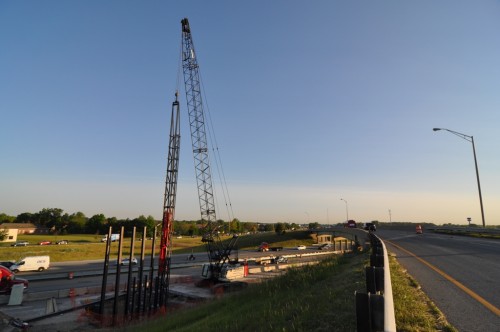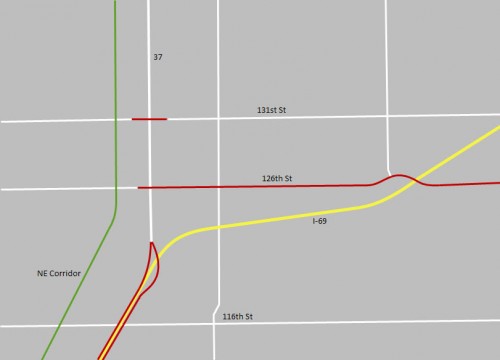
Last week, INDOT commenced work on I-69 at the interchange with state road 37 and 116th street, on Indianapolis’ NE side. According to INDOT’s page on the project, work is being conducted,
“To alleviate the existing bottleneck at the I-69 interchange at 116th Street/State Road 37 (SR 37), the current design will be reconfigured.”
 The work will obstruct traffic flow for the 2012 & 2013 construction season. At first read, this project is much cheaper and less invasive than the previously proposed $500 million reconfiguration of the entire stretch of 69 from 465 north to Exit 5. However, this appears to be more business as usual for INDOT. Indeed, the passage above illustrates that this work will alleviate the existing bottleneck.
The bigger question though should be, what will INDOT do when the new interchange design becomes obsolete and congested? History has shown us that freeway expansion induces more travel along newly added capacity. Indeed, that is why this project is taking place. Managing highway congestion with lane widening and addition never truly solves the demand side of the equation. In addition to this work, the Town of Fishers, who will be the direct beneficiary of the newly added capacity, has a program appropriately named, Drive Fishers, that aims to add capacity and streamline traffic flow; a number of the program’s focused improvements occur on 37, just north of where th I-69 project is being undertaken.
As a whole, these projects will add traffic capacity and speed vehicles to their suburban destinations much quicker than they do today. That can be seen as a plus when viewed through the lens of an automobile driver. However, as a pedestrian, cyclist or alternative transportation advocates, it should be viewed as a detriment to healthy lifestyles. History also shows that new road expansion will lead to new development and with this corridor being nearly all automobile focused, expect more automobile dealerships, fast food restaurants and other associated automobile based commercial outlets. The lone pedestrian project being undertaken, is the 126th street multi-use trail project which accompanies the divided highway expansion from 2 to 4 lanes of 126th street.

Sadly, the NE Corridor project which parallels this stretch of road, is still stuck in neutral thanks to inaction at the state level over the requested authority to establish a Regional Transit Authority (RTA) and levy taxes for the regional transit system advocated by Indy Connect. It would have been a welcome gesture by the Town of Fishers and INDOT if the money being spent on traffic flow and capacity improvements had instead been spent on bringing regional transit to fruition and reducing further dependence on automobile commuting for residents on the NE side of Indy.
To increase capacity for rail transit, we can simply add another car at peak times.
To increase capacity for auto transit, we must build permanent stretches of underutilized concrete for peak hours…………I’d vote for the first method!
Fishers and INDOT should pull up a 1959 Eisenhower memo stating that the intent of the Interstate Highway System was never meant to be a intra-city system but was mislead into it by various interests and lobbies. Maybe Fisher’s residents and the rest of the people on the NE side and suburbs will someday realize that commuter rail would be a less stressful commute downtown, but I don’t live up there, so let them spend two hours a day in traffic if they want.
An even less-stressful commute downtown would be from Butler-Tarkington, Meridian Kessler, Arden, Glendale/Broad Ripple, Devonshire, Irvington, Near East Side, Beech Grove, Speedway, Augusta/New Augusta, Nora, Sylvan Ridge, Steinmeier, North Willow/College Park…pretty much any neighborhood or area inside 465.
I agree with Eric, too many people are unaware of the benefits rail brings.
Sadly, Eric & Brandon are both completely correct. In and around Indy, transit is primarily seen as transportation for “poor people,” and given the horrible connectivity and scheduling, pretty much lives up to that reputation. I would love to take IndyGo if it actually went places I wanted to go, when I wanted to go there, in a time frame at least comparable to how long it takes me to bike there. But sadly, that rarely happens, and I pretty much stick to my bike.
IndyGo badly needs a PR overhaul if they’re going to have any iota of political leverage for funding/expansion in the future. Indy Connect definitely helped with that, but instead of spinning off the momentum built by the Indy Connect public outreach, all the talk of transit expansion just kind of fizzled and settled back into the urban development blogs. But, at least IndyGo has overhauled their website?…
another loss for Fi-town: Enjoy the extra CONVENIENCE of living in your automobile!!!